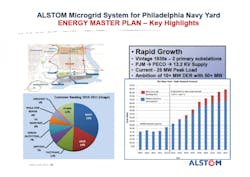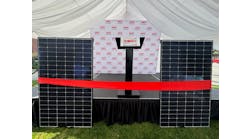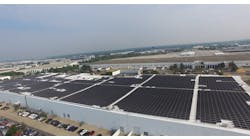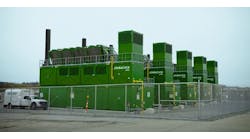Large ports and maritime facilities make regular, intensive use of some of the largest, heaviest and most power-hungry machinery and equipment manufactured. Serving their energy needs is no small task, whether it be via conventional grid, distributed energy resources, or a mix of both. So it seems appropriate that one of the most ambitious projects in the US is being developed where the US Navy was born: the Philadelphia Navy Yard microgrid.
At present, the 1200-acre Navy Yard purchases around 98 percent of the electricity used from Constellation Energy. Exelon-owned PECO delivers it to the Navy Yard. This power and energy profile will take a dramatically different shape and form as the Navy Yard completes its microgrid project, a $4 billion master energy plan and 35-MW hybrid microgrid.
The Navy Yard is more than a shipyard, as significant as that is. It’s a national historic landmark and Philadelphia institution that’s being transformed into a magnet and hub for smart energy innovation, sustainable business and local community development. Managing the project is PIDC, Philadelphia’s economic development agency.
Microgrid Knowledge recently got back in touch with Jayant Kumar, lead project contractor at GE Alstom and director of all things smart grid, to obtain a project status report. Phase one of the ambitious project is essentially complete and project partners are keen to move forward, he told Microgrid Knowledge in an interview.
A wholesale grid transition
Transitioning from wholesale reliance on utility grid power, the Philadelphia Navy Yard expects to realize a cumulative total of over 61,000 MWh in energy savings over the course of the microgrid’s service life. By and large, the gains are projected to come by taking advantage of a mix of on-site distributed power and energy generation, energy storage and energy efficiency projects, programs and technology, all of which is expected to be complete in 2022.
Furthermore, the design plan focuses on building in capacity so that the Navy Yard and local area utility grid can flexibly adapt and meet rising energy consumption. Of particular note, the energy master plan aims to expand use of natural gas and local renewables in ways that enhance Navy Yard and community grid independence and energy security, as well as the reliability, efficiency, capacity and resilience of PECO’s local distribution grid.
PIDC’s planned 35-MW Navy Yard hybrid microgrid project lies at the core. Unsurprisingly, the project is extensive both in scope and scale. Whether connected to the grid or in island mode, the microgrid is expected to support the energy needs of:
- Seven million square feet of occupied industrial, R&D and office space
- 145 companies
- Three Navy activities
- More than 11,500 employees
In addition to the annual energy cost savings, the $4 billion project is expected to yield an annual $11 billion worth of local and state benefits, as well as $275 million in state and local tax revenue.
An energy master plan
At full build-out the Navy Yard microgrid should support the electricity and energy needs of 30,000 employees, 1,500 residential units and 15-plus million square feet of occupied space. Marking a project milestone, Chicago-based Ameresco on August 8 announced it had begun construction of the hybrid microgrid’s centerpiece, a 6-MW natural gas-fired peaker plant. The peak-period generator is slated to come online in November, Kumar told Microgrid Knowledge late last week.
Philadelphia Navy Yard power: Before and after
I. Business as usual – 100% utility fed
All PECO supply
No onsite generation (DG)
No proactive energy efficiency or demand response effort
Navy Yard utility demand 82 MWWith hybrid microgrid and grid modernization
- On-site DG grid programs:
Natural gas 6 MW peak reduction
3-MW combined heat and power (data center)
1 MW solar PV
600 kW fuel cell
Navy Yard net utility demand 72 MW- Demand response & energy efficiency
Customer programs – 20 percent energy efficiency goal by 2022
Navy DOD mandates − BTM (beyond the meter) demand reduction
Navy Yard net utility demand 60 MW
Socioeconomic and environmental benefits
More broadly, the ultimate goal of the Navy Yard’s Master Energy Plan is to upgrade and modernize the facility and utility community grid service so that it provides sustainable, competitively priced energy to all customers and serves as a platform for customer engagement and energy choice.
The Navy Yard also is meant to serve as a private sector and community magnet and hub able to attract and sustain investment energy innovation and testing. Key to this is creation of an on-site smart energy campus, which will include lab and test bed facilities, along with self-funding business models for ongoing development.
A five-point action plan lays out the business models that will support the Navy Yard microgrid financially, as well as the resources and prospective business models, programs and partnerships tenants can take advantage of. These are:
- Infrastructure: Capacity, Generation/Supply, Technology Microgrid
- Microgrid Business Model: Forecasts, Tariffs, Procurement, O&M,
- Capital Building Owner Opportunities: Distributed generation (DG),
- Energy efficiency (EE), Demand Response (DR) – Programs & Partnership
- Test Bedding Outreach and Protocols: Energy Innovation Campus
- Carbon Reduction and Sustainability: Reduce Carbon Intensity
Phase one of the Navy Yard’s energy master plan is essentially complete, according to Kumar. That includes installing:
- Additional switchgear in a primary substation
- Advanced metering infrastructure (AMI) with a master data management system (MDMS), and
- A centralized Grid NOC (Network Operations Center).
In turn, the Grid NOC is equipped with:
- A full-function SCADA (Supervisory Control and Data Acquisition) platform
- Electronic relay devices
- High-performance data concentrator servers, and communications equipment at all major substations
- An OSIsoft-PI ‘Data Historian’ and system analysis tool (an open systems framework, distributed computing software application being used in creating Internet of Things networks.
Work in progress
Turning to work underway, PDIC, GE Alstom and other project partners are approaching completion of:
- A new primary substation that initially will boost external utility grid power by 10 MW, expandable to 20 MW
- 500 kW of community solar photovoltaic (PV) power generation, with a second, 300 kW installation to follow
- Infrastructure upgrades, including a second major loop circuit and starting work on a third to enhance resilience
- Removal of outdated 5 kV primary service and upgrading to the present regional standard of 15 kV.
Kumar noted that phase one of the microgrid and grid modernization initiative has proceeded with little, if anything, in the way of variation from the Navy Yard master energy plan.
Track progress on the Navy Yard microgrid by subscribing to the Microgrid Knowledge newsletter. It’s free.







